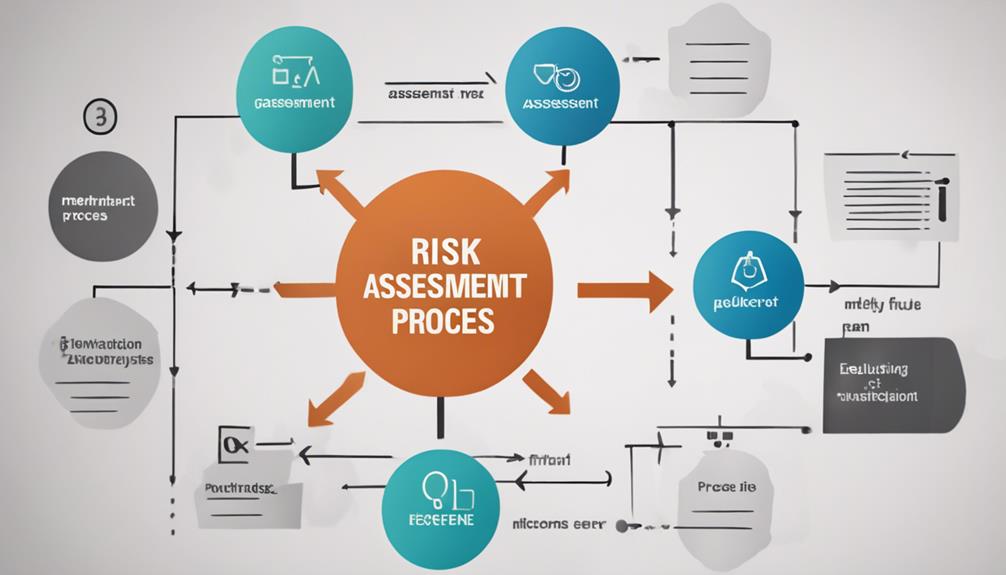In managing risks within merchant services, start by identifying specific risks and conducting thorough assessments to secure transactions. Pay attention to payment processing risks like fraud and security, market risks affecting brand reputation, and compliance requirements. Implement fraud prevention techniques, effective chargeback strategies, and robust security measures with encryption protocols. Address currency fluctuations and leverage technology like tokenization and AI for risk mitigation. Develop a complete risk management plan tailored to address fraud, chargebacks, and compliance. Prioritize clear communication strategies and customer trust to safeguard your business. Further insights on risk management await, guiding you to secure operations effectively.
Key Takeaways
- Conduct thorough risk assessments to identify vulnerabilities.
- Implement robust fraud prevention techniques.
- Focus on chargeback management strategies.
- Ensure security and compliance measures are in place.
- Utilize technological solutions for risk mitigation.
Risk Assessment Process

Identify and classify risks specific to your merchant services environment to kickstart the risk assessment process effectively.
In the domain of merchant services, conducting a thorough risk assessment is vital to secure financial transactions and safeguard operations. By analyzing vulnerabilities within your infrastructure and operations, you can pinpoint potential threats such as cybersecurity threats, compliance risks, and other vulnerabilities that may compromise the integrity of your system.
Assigning severity levels to these risks based on their potential impact on financial transactions is important for prioritizing risk mitigation efforts. Understanding the risk assessment process not only helps in identifying risks but also aids in implementing strategies to mitigate them effectively.
This proactive approach is essential in combating fraudulent activities and ensuring compliance with industry standards. Therefore, investing time and resources into a detailed risk assessment tailored to your merchant services environment is fundamental for long-term security and stability.
Types of Risks in Merchant Services

When it comes to managing risks in merchant services, it's essential to understand the various types of risks that can impact your business. Payment processing risks, fraud prevention strategies, and compliance requirements are key areas to focus on to safeguard your operations.
Payment Processing Risks
Managing risks in merchant services involves maneuvering various payment processing risks that can impact financial stability and operational efficiency. Payment processing risks include fraud, chargebacks, security, compliance, financial, and advanced fraud detection.
Fraud risk involves unauthorized activities like payment card fraud and identity theft. Chargeback risk arises from customer transaction disputes, leading to financial losses. Security and compliance risks encompass data breaches, unauthorized access, and regulatory non-compliance. Financial risks may stem from currency and exchange rate fluctuations, requiring strategies such as hedging.
Market and reputational risks pose threats to brand reputation and trust. Effective risk management practices, including advanced fraud detection tools, are essential for mitigating these risks and ensuring smooth payment processing operations for merchants.
Fraud Prevention Strategies
To enhance financial security and protect against potential risks, implementing robust fraud prevention strategies is imperative in merchant services. Fraudulent transactions, including payment card fraud and chargebacks, can lead to substantial financial losses. Cybersecurity threats such as data breaches and malware attacks further underline the necessity for strong prevention measures. Non-compliance with industry regulations poses additional risks, emphasizing the importance of compliance risk management. Leveraging technologies like tokenization, encryption, machine learning, and blockchain can greatly enhance fraud prevention capabilities and secure financial transactions. By adopting these advanced tools and strategies, businesses can effectively mitigate fraud risks and uphold the integrity of their merchant services.
| Fraud Prevention Strategies | ||
|---|---|---|
| Tokenization | Encryption | Machine Learning |
| Blockchain | Financial Transactions |
Compliance Requirements Understanding
Understanding compliance requirements in merchant services is pivotal for mitigating risks and ensuring regulatory adherence to safeguard financial transactions. To grasp this critical aspect effectively, consider the following:
- Non-compliance can result in substantial fines and legal repercussions.
- Compliance risks include failure to adhere to PCI DSS standards, AML regulations, and data protection laws.
- Merchant service providers must stay updated on evolving compliance requirements to protect against regulatory violations.
Fraud Prevention Techniques

For effective fraud prevention in merchant services, implement robust authentication processes and utilize fraud detection tools to thwart unauthorized activities for financial gain. By incorporating security measures like encryption protocols and access control measures, you can address compliance issues and regulatory risks effectively. To mitigate chargeback risks, establish transparent communication, provide prompt customer service, and train employees on procedures.
Continuous monitoring of chargebacks, website visits, and transaction numbers is important. Employing third-party monitoring solutions can enhance fraud detection and monitoring, reducing financial losses. Tailored monitoring programs based on merchant characteristics, such as multiple purchases and cardholder numbers, enable quick detection and control of fraud losses.
Chargeback Management Strategies

When managing chargebacks, it's essential to focus on prevention methods to minimize disputes. Effective dispute resolution is key to maintaining a positive relationship with customers and avoiding financial losses.
Chargeback Prevention Methods
To effectively mitigate chargebacks in merchant services, implementing robust authentication processes and utilizing fraud detection tools is essential. When it comes to chargeback prevention, consider the following:
- Transparent Communication: Keep customers informed about transactions to avoid misunderstandings.
- Employee Training: Educate staff on chargeback procedures to handle disputes effectively.
- Establish Policies and Procedures: Clearly define protocols to reduce chargeback occurrences.
Effective Dispute Resolution
A key aspect of effective dispute resolution in merchant services involves promptly addressing customer transaction disputes to minimize financial losses from chargebacks. Timely responses to chargebacks are essential to prevent revenue loss. Implementing transparent communication and clear policies can aid in resolving chargeback disputes efficiently.
Utilizing data analytics and tracking chargeback trends can inform proactive decisions in chargeback management. By staying informed about chargeback trends and responding promptly with data-driven strategies, merchants can effectively manage disputes and reduce financial risks associated with chargebacks.
Clear policies and transparent communication play an important role in ensuring that disputes are handled in a way that minimizes revenue loss and maintains positive relationships with customers.
Security and Compliance Measures

Implement encryption protocols to safeguard sensitive data and prevent unauthorized access for robust security and compliance measures in merchant services. To enhance security and ensure compliance, consider the following measures:
- Regularly conduct audits to assess adherence to industry regulations and standards.
- Establish stringent access control mechanisms to restrict unauthorized individuals from compromising system security.
- Provide thorough employee training on security protocols and best practices to mitigate potential risks effectively.
Currency and Cross-Border Risks

Currency and exchange rate fluctuations pose significant challenges in cross-border transactions, necessitating strategic approaches to mitigate financial risks effectively.
When engaging in international transactions, it's imperative to contemplate the potential impact of currency volatility on your financial outcomes. By understanding how exchange rate fluctuations can affect the value of transactions, you can better manage currency risk.
Utilizing hedging instruments such as forward contracts can help safeguard your business from unexpected currency movements. Collaborating with financial institutions to develop tailored strategies based on your specific needs and risk tolerance can further enhance your ability to navigate cross-border payment risks.
Additionally, implementing dynamic pricing strategies and diversifying your currency holdings can help spread risk and optimize your international transactions.
Reputational Risk Management

Preserving your company's image and credibility is the core focus of reputational risk management. To effectively manage reputational risk, consider the following strategies:
- Implement clear communication: Transparently communicate your company's policies and practices to prevent misunderstandings that could damage your reputation.
- Prioritize customer trust and loyalty: Cultivate trust with customers through consistent positive interactions and reliable services can enhance loyalty and mitigate reputational risks.
- Foster a positive brand perception: Aim to maintain a positive image in the eyes of your customers and stakeholders by delivering on promises and exceeding expectations.
A strong focus on reputational risk management not only safeguards your company against potential pitfalls like unethical behavior or poor customer service but also positions your business for a competitive edge and long-term success in the market. Remember, a positive reputation is a valuable asset that can set you apart from competitors and attract loyal customers.
Creating a Risk Management Plan

To effectively safeguard your merchant services operations and mitigate potential risks, it's crucial to craft a thorough risk management plan tailored to address fraud, chargeback, and regulatory concerns. Begin by conducting detailed risk assessments specific to your operations to identify vulnerabilities.
Implement robust authentication processes and encryption protocols to effectively mitigate security and compliance risks. Clear communication of policies and practices is vital to prevent misunderstandings and enhance risk management efforts.
Develop a detailed risk management plan that encompasses fraud prevention, chargeback mitigation, and regulatory compliance. Regularly monitor and adapt this plan to guarantee proactive risk prevention and effective mitigation strategies are in place.
Technological Solutions for Risk Mitigation

Utilizing advanced technological solutions is paramount in effectively mitigating risks in merchant services and ensuring the security of payment transactions. Implementing these tools not only enhances security but also aids in fraud prevention and maintaining transaction integrity.
Here are three key technological solutions for risk mitigation:
- Tokenization: Replacing sensitive cardholder data with unique tokens helps enhance security and protect against data breaches.
- Encryption: Utilizing strong algorithms safeguards payment information and prevents unauthorized access, ensuring data security.
- Machine Learning and AI Technologies: By analyzing transaction patterns in real-time, these tools can detect and prevent fraudulent activities, bolstering overall security measures.
Incorporating these technologies, along with blockchain technology, can provide a robust framework to reduce the risk of security breaches and fraudulent activities, ultimately ensuring a safer and more secure payment environment for merchants and customers alike.
Frequently Asked Questions
How Do You Identify and Manage Risk?
To identify and manage risk effectively, you need to conduct thorough assessments, implement fraud detection tools, adhere to compliance protocols, use encryption technology, and monitor risk severity levels regularly.
By following these steps, you can proactively address vulnerabilities and potential threats in merchant services.
Remember to stay vigilant and adapt your risk management strategies as needed to protect against fraudulent activities and regulatory risks.
What Are the Five 5 Major Activities of Risk Management?
In risk management, the five major activities are identification, assessment, mitigation, monitoring, and communication. These steps help you recognize potential threats, evaluate their impact, reduce risks through proactive measures, continuously track and adapt strategies, and keep stakeholders informed.
This process is essential for safeguarding businesses against various risks like fraud, cybersecurity threats, and compliance issues. Mastering these activities guarantees effective risk management in merchant services.
How Do You Mitigate Merchant Risk?
To mitigate merchant risk effectively, you need to implement robust fraud detection systems and utilize advanced technologies such as machine learning.
Establish clear policies, conduct regular risk assessments, and collaborate with payment processors to tailor risk management solutions.
What Risks Will the Merchants Face?
Merchants face a range of risks in their operations, including fraud, chargebacks, cybersecurity threats, and compliance issues. Unauthorized activities for financial gain and customer transaction disputes are major concerns that must be managed effectively.
Other risks include data breaches, unauthorized access, non-compliance with regulations, and currency exchange rate fluctuations impacting transactions. Failure to address these risks can lead to damage in brand reputation and trust, affecting the merchant's success.
Conclusion
Just as a ship relies on a compass to navigate through turbulent waters, businesses in the merchant services industry must use risk management strategies to steer clear of potential dangers.
By identifying and managing risks effectively, companies can safeguard their financial well-being and reputation.
Remember, staying vigilant and proactive in addressing risks will help you chart a course towards success in the ever-changing landscape of merchant services.










